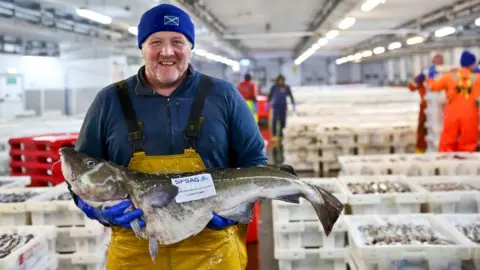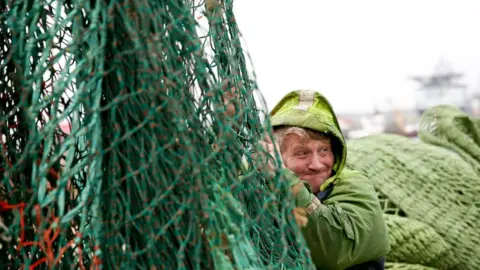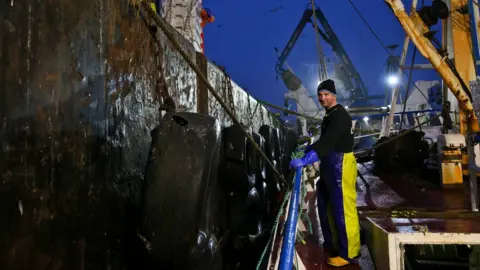North Sea cod can be eaten with 'clear conscience'
 Eleanor Church/Lark Rise Pictures
Eleanor Church/Lark Rise PicturesNorth Sea cod is now sustainable and can be eaten with a "clear conscience", a fisheries body has said.
The fish has been considered under threat for more than a decade after stocks fell to 36,000 tonnes in 2006.
But the industry has agreed measures to help regenerate the population, including new nets and closing spawning areas to fishing.
The Marine Stewardship Council (MSC) said it could now be sold with its "blue tick" label.
The label indicates that North Sea cod caught by Scottish and English boats is "sustainable and fully traceable".
Cod stocks in the North Sea reached 270,000 tonnes in the 1970s. After the 2006 low, the fishing industry began work with the Scottish government and the EU Fisheries Council to agree a recovery plan.
The MSC said the announcement that cod was now sustainable was a "momentous achievement" for the industry and was the result of work of a coalition of fishing organisations, supermarkets, seafood brands and the industry body Seafish.
However, conservation body WWF has warned that historically, the population of North Sea cod remains at a low level.
The stocks have to be independently assessed before they can be given the MSC blue tick.
 Eleanor Church/Lark Rise Pictures
Eleanor Church/Lark Rise Pictures Eleanor Church/Lark Rise Pictures
Eleanor Church/Lark Rise PicturesCod is one of the UK's most popular fish, with almost 70,000 tonnes eaten each year, but the MSC said a recent YouGov survey showed there was confusion about whether it was sustainable or not.
Toby Middleton, MSC programme director for the north-east Atlantic said: "Today's certification marks the end of the cod confusion.
"If you can see the MSC label on your cod, you know that it has come from a sustainable source. By choosing fish with that label, you will be helping to protect stocks long into the future."
He added: "Thanks to a collaborative, cross-industry effort, one of our most iconic fish has been brought back from the brink.
"Modified fishing gear, catch controls, well-managed fishing practices - all these steps have come together to revive a species that was in severe decline."
As part of the plan to regenerate stocks, boats were allocated a certain number of days fishing which were linked to the conservation measures they signed up to.
The fishing industry is also able to close fishing areas at short notice to protect local populations and has developed a system of remote monitoring using CCTV cameras on board boats.
Mike Park, chairman of the Scottish Fisheries Sustainable Accreditation Group said: "This is a massive development for the catching sector and is a testament to the power of collective action.
"The years of commitment to rebuilding North Sea cod has shown that fishermen are responsible and can be trusted to deliver stable and sustainable stocks. The consumer can now eat home-caught cod with a clear conscience."
However, the WWF has warned that the population levels of North Sea cod remained low compared with 50 years ago.
Lyndsey Dodds, head of UK marine policy at WWF said: "The recovery of cod in the North Sea reflects what's possible if fishermen work together with fisheries managers, scientists and the wider industry to recover fish stocks.
"However, the amount of North Sea cod at breeding age is well below late 1960s levels and recovery remains fragile.
"If we're to get North Sea cod back on British plates for good, it's vital that we don't lose focus on sustainably managing fish stocks and ensuring the protection of the marine wildlife and habitats as the UK develops its post-Brexit fisheries policy.
"Embracing new technology and installing cameras on the UK fleet would be a highly cost-effective and efficient way to help manage and monitor cod catches, as well as the range of other fish also caught by these boats."